TRANSFER ASSEMBLY
The TRANSFER ASSEMBLY transfers power from the transmission to the rear axle or front and rear axles of a vehicle. Only vehicles with four-wheel drive require a transfer assembly. 2016 TITAN XD incorporates a heavy-duty transfer assembly (TX91A) to handle the power from the Cummins® 5.0L V8 Turbo Diesel engine and to transfer all that power to the beefy American Axle Manufacturing axles to provide impressive traction and hauling capability.
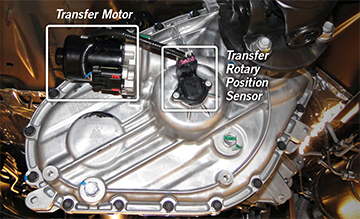
TRANSFER ASSEMBLY BASICS
The 2016 TITAN XD transfer assembly can operate in three different modes that the driver can select on the drive mode selector switch located on the instrument panel. The three available modes are standard two-wheel drive (2WD), four-wheel drive Hi (4H) and four-wheel drive Low (4LO). The 4WD switch adjusts the transfer assembly electronically via the transfer motor. The transfer rotary position sensor, mounted on the transfer assembly, monitors the gear position and sends the information back to the instrument cluster for display on the combination meter.
COMPONENTS AND OPERATION
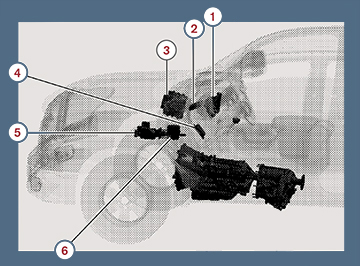
- Combination Meter The combination meter transmits the vehicle speed signal to the transfer control unit via CAN communication. The combination meter receives the 4WD warning lamp signal, 4WD mode indicator lamp signal, and ATP warning lamp signal from the transfer control unit via CAN communication.
- Body Control Module (BCM) The BCM transmits the sleep wake up signal and stop lamp switch signal to the transfer control unit via CAN communication. The BCM receives the sleep-ready signal from the transfer control unit via CAN communication.
- Engine Control Module (ECM) The ECM transmits the engine speed signal to the transfer control unit via CAN communication.
- Transmission Control Module (TCM) The TCM transmits the gear position signal and output shaft revolution signal to the transfer control unit via CAN communication.
- ABS Actuator and Electric Unit (Control Unit) The ABS actuator and electric unit (control unit) transmits each wheel speed signal to the transfer control unit via CAN communication.
- Transfer Control Unit The transfer control unit controls 4WD mode (2WD ↔ 4H ↔ 4LO) by input signals of each sensor and each switch, and it directs shifts from the 4WD shift switch.
- 4WD Shift Switch The 4WD shift switch is installed on the instrument cluster. The 4WD shift switch enables the selection of the three drive modes (2WD ↔ 4H ↔ 4LO).
- Range Sensor The range sensor is installed on the top of the transfer assembly. The range sensor detects the engagement status of 4H-4LO sleeve and transmits a signal to the transfer control unit.
- Mode Sensor The mode sensor is installed on top of the transfer assembly. The mode sensor detects the engagement status of the 2WD-4H sleeve and transmits a signal to the transfer control unit.
- Transfer Motor The transfer motor is installed on the left side of the transfer assembly. The transfer motor operates according to signal from the transfer control unit and switches 4WD mode (2WD ↔ 4H ↔ 4LO).
- Transfer Rotary Position Sensor The transfer rotary position sensor is installed on the back of the transfer assembly. The transfer rotary position sensor detects the rotation status of the transfer motor and transmits a signal to the transfer control unit.
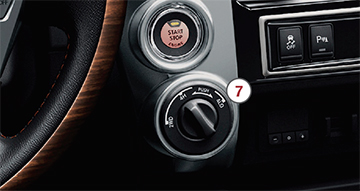
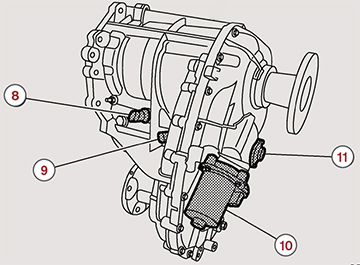
OPERATION SYSTEM DIAGRAM
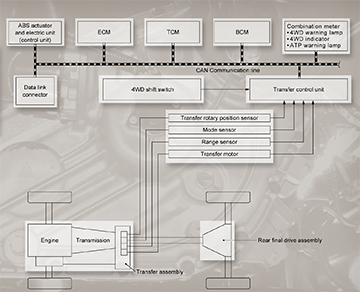
OPERATION SYSTEM SECTIONAL VIEW
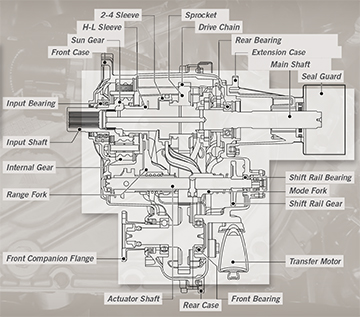
OPERATION SYSTEM TORQUE DISTRIBUTION FLOW 2WD MODE Gear Ratio 1.000
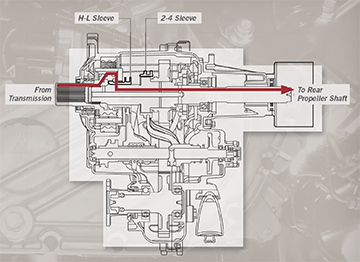
OPERATION SYSTEM TORQUE DISTRIBUTION FLOW 4H MODE Gear Ratio 1.000
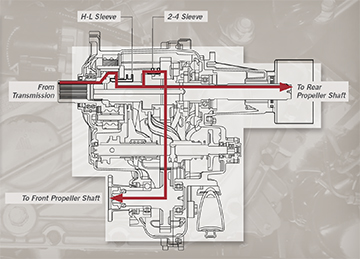
OPERATION SYSTEM TORQUE DISTRIBUTION FLOW 4LO MODE Gear Ratio 2.717
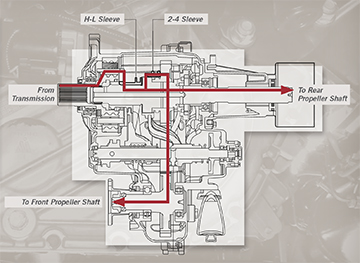
INSPECTION AND MAINTENANCE
The 2016 TITAN XD transfer assembly holds 1-7/8 quarts (1.8L) of genuine Nissan ATF D3M fluid, or its equivalent. It should be inspected every 12 months or 10,000 miles/kilometers (whichever comes first). Be sure to inspect the area around the transfer assembly for fluid leaks. Check the oil seal, drain plug, filler plug, and so on.
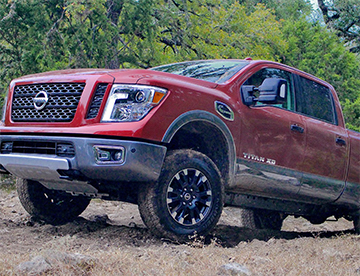
To check the fluid level, remove the filler plug. The plug itself is secured with high-performance silicone sealant. Once the plug is out, place your finger in the filler plug hole to check the fluid level. Fluid should be filled to the bottom of the filler plug hole.
Before you replace the filler plug, be sure to clean any residual sealant from the filler plug threads. Then apply fresh sealant to the filler plug. Thread it back into the filler plug hole and tighten to the recommended torque level.
If you need to drain fluid from the transfer assembly, first make sure the engine is OFF. Remove the drain plug and let the transfer fluid drain out. Again, removeany old sealant from the threads of the drain plug, replace with fresh sealant and screw the fill plug back in.
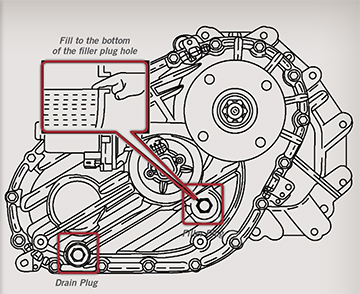
- Once the used transfer fluid has been drained and you have replaced the drain plug, you can add fresh fluid to the transfer assembly.
- Remove the filler plug and pour new transfer fluid until it is level with the bottom of the filler plug hole. This should take about 3 minutes.
- Once the fluid is level with the bottom of the plug hole, let it sit for 3 minutes, then re-check the fluid level.
- Once the fluid is stable at the proper level, you can clean the filler plug, apply fresh sealant and replace the filler plug to the recommended torque.

Was this article helpful? We value your opinion! Email us at TechTalk@nissan-usa.com.